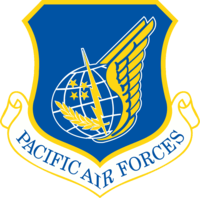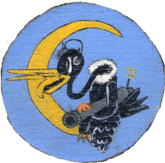609th Special Operations Squadron
609th Special Operations Squadron
 | |
|---|---|
|
609th SOS B-26K engine start at Nakhon Phanom | |
| Active | 1942-1944; 1944-1945; 1967-1969 |
| Country |
|
| Branch |
|
| Role | Special Operations |
| Part of | Pacific Air Forces |
| Nickname(s) | Nimrods |
| Engagements | Vietnam War |
| Decorations |
Presidential Unit Citation Air Force Outstanding Unit Award with Combat "V" Device Republic of Vietnam Gallantry Cross with Palm |
| Insignia | |
| Patch with 609th Special Operations Squadron emblem |
|
| 349th Night Fighter Squadron emblem (Approved 18 January 1944)[1] |
 |
The 609th Special Operations Squadron is an inactive United States Air Force unit. Its last assignment was with the 56th Special Operations Wing at Nakhon Phanom Royal Thai Navy Base, Thailand. The squadron served for two and a half years combat duty during the Vietnam War, primarily flying missions over the Ho Chi Minh Trail in Laos. It earned several decorations, including the Presidential Unit Citation, before it was inactivated in December 1969.
The first predecessor of the squadron was the 349th Night Fighter Squadron, which served as a night fighter training unit in Florida and California until it was disbanded in a reorganization of Army Air Forces training units and replaced by the 450th AAF Base Unit.
The second predecessor of the 609th was the 329th Transport Squadron, which was organized overseas to provide airlift services in the Mediterranean Theater of Operations
History
Night fighter training

The 349th Night Fighter Squadron was formed at Orlando Army Air Base, Florida in October 1942 as part of the Army Air Force School of Applied Tactics Fighter Command School from elements of the 81st Fighter Squadron. Its personnel were veteran American pilots trained by the Royal Air Force in night interception operations. It was initially equipped with three Douglas DB-7s and twenty-three Douglas P-70s. Shortages in operational flying aircraft, spare parts and other issues kept flying training very rudimentary for the squadron's first classes that graduated in December 1942.[2]
As 1943 progressed additional aircraft and equipment arrived and the program expanded. In September, the first American-built dedicated night fighter began to arrive, the YP-61, and a few production Northrop P-61A Black Widows. In January 1944 the entire night fighter training program moved to Hammer Field, California and was placed under IV Fighter Command. The move placed the squadron nearer to Northrop Aircraft manufacturing facility at Hawthorne, California. Most P-61 squadrons trained by the squadron were planned to deploy for operations in the Pacific and China Burma India Theaters.[2]
In March 1944 the 348th was disbanded when the AAF found that standard military units, based on relatively inflexible tables of organization were proving less well adapted to the training mission. Accordingly, a more functional system was adopted in which each base was organized into a separate numbered unit during a reorganization of units in the United States.[3] The squadron's personnel and equipment were transferred to Squadron B of the 450th Army Air Forces Base Unit (Night Fighter Replacement Training Unit).[2]
Airlift in the Mediterranean Theater
The 329th Transport Squadron delivered cargo and mail throughout the Mediterranean Theater of Operations from its activation in March 1944 until it was inactivated in September 1945. The squadron was disbanded in 1948, then reconstituted in 1985 and consolidated with the 609th.[4]
Combat Operations During the Vietnam War

The 609th Special Operations Squadron was organized as the 609th Air Commando Squadron at Nakhon Phanom RTAFB, Thailand on 15 September 1967. It was assigned to the 56th Air Commando Wing. The squadron flew the Douglas A-26 Invader, a twin engine attack bomber of WWII vintage. These aircraft were transferred from the 606th Air Commando Squadron which transitioned to other aircraft. The primary mission of the 609th was night interdiction of truck traffic along the Ho Chi Minh Trail. Its call sign for these missions was "Nimrod", inherited from the 606th and other squadrons that had flown that mission, and "The Nimrods" soon became the squadron's nickname. The squadron's A-26 aircraft carried tail letters "TA".
On 1 August 1968, all Air Commando Wings were redesignated as Special Operations Units, and the 56th Air Commando Wing became the 56th Special Operations Wing, with the 609th Air Commando Squadron becoming the 609th Special Operations Squadron.[4][5]
The night interdiction tasks of the 609th were gradually taken over by squadrons flying Lockheed AC-130 gunships, and the A-26 aircraft were phased out of active service by November 1969.[5] By the time the last four surviving A-26s were withdrawn at the unit stand down, the squadron had flown 7,159 combat missions, and been credited with destroying 4,268 enemy supply trucks.[6]
The 609th was inactivated on 1 December 1969. The squadron's losses had been heavy, and it was awarded the Presidential Unit Citation for gallantry.[5]
The remains of two squadron pilots, Maj. James E. Sizemore and Maj. Howard V. Andre, shot down over Laos in 1969, were recovered in 2013 and buried at Arlington National Cemetery[7]
Lineage
- 349th Night Fighter Squadron
- Constituted as the 349th Night Fighter Squadron on 1 October 1942
- Activated on 4 October 1942
- Disbanded on 31 March 1944[1]
- Reconstituted on 19 September 1985 and consolidated with the 609th Special Operations Squadron
- 329th Transport Squadron
- Constituted as the 329th Transport Squadron (Cargo & Mail), Light on 12 May 1944
- Activated on 31 May 1944
- Inactivated on 9 September 1945
- Disbanded on 8 October 1948
- Reconstituted on 19 September 1985 and consolidated with the 609th Special Operations Squadron
- 609th Special Operations Squadron
- Constituted as the 609th Air Commando Squadron on 22 August 1967 and activated (not organized)
- Organized on 15 September 1967
- Redesignated 609th Special Operations Squadron on 1 August 1968
- Inactivated on 1 December 1969
Assignments
- Fighter Command School, 4 October 1942[1]
- Army Air Forces School of Applied Tactics, 21 January 1943[1]
- 481st Night Fighter Operational Training Group, 26 July 1943[1]
- Fourth Air Force, 15 January 1944 – 31 March 1944[1]
- Mediterranean Air Transport Service, 31 May 1944 – 9 September 1945
- Pacific Air Forces, 22 August 1967 (not organized)
- 56th Air Commando Wing (later 56th Special Operations Wing), 15 September 1967 - 1 December 1969.[4]
Stations
- Kissimmee Army Air Field, Florida, 4 October 1942[1]
- Hammer Field, California, 15 January - 31 March 1944[1]
- Capodichino Airport, Naples, Italy, 31 May 1944 - 9 September 1945
- Nakhon Phanom Royal Thai Navy Base, Thailand, 15 September 1967 - 1 December 1969[4]
Commanders
- Lt Col William R. Yancey, January 1943-31 March 1944[8]
- Maj James E. Scoggins Jr., 31 May 1944
- Capt William E. Gedecke, c. June 1944
- Capt Bernard J. Weist, 24 August 1944 - unknown
- Lt Col Allen F. Learmonth, 15 September 1967
- Lt Col Robert E. Brumm, by 31 March 1968
- Lt Col John J. Shippey, by 30 September 1968
- Lt Col Robert L. Schultz, by 31 December 1968
- Lt Col Robert W. Stout, by 30 September 1969
- Lt Col Jackie R. Douglas, by 30 October 1969 – 1 December 1969[4]
Aircraft
- Douglas DB-7, 1942[1]
- L-6, 1942–1943[1]
- Northrop P-61 Black Widow, 1942–1944[1]
- Douglas P-70 Havoc, 1942–1944[1]
- Boeing B-17 Flying Fortress, 1944–1945
- North American B-25 Mitchell, 1944–1945
- Douglas C-47 Skytrain, 1944–1945
- Douglas C-53 Skytrooper, 1944–1945
- Douglas A-26 Invader, 1967-1969.[4]
Awards and Campaigns
| Award streamer | Award | Dates | Notes |
|---|---|---|---|
| Presidential Unit Citation | 1 October 1967–30 April 1968 | 609th Air Commando Squadron (later 609th Special Operations Squadron)[4] | |
| Presidential Unit Citation | 1 November 1968-1 May 1969 | 609th Special Operations Squadron[4] | |
| Presidential Unit Citation | 1 October 1969-1 December 1969 | 609th Special Operations Squadron[4] | |
| Air Force Outstanding Unit Award with Combat "V" Device | 1 July 1968–1 December 1969 | 609th Special Operations Squadron[4] | |
| Vietnamese Gallantry Cross with Palm | 15 September 1967-1 December 1969 | 609th Air Commando Squadron (later 609th Special Operations Squadron)[4] |
| Campaign Streamer | Campaign | Dates | Notes |
|---|---|---|---|
| American Theater without inscription | 9 October 1942 – 31 March 1944 | 349th Night Fighter Squadron[1] | |
| Rome-Arno | 31 May 1944 – 9 September 1944 | 329th Transport Squadron[4] | |
| Vietnam Air Offensive, Phase II | 15 September 1967 – 31 March 1968 | 609th Air Commando Squadron[4] | |
| Vietnam Air/Ground | 22 January 1968 – 7 July 1968 | 609th Air Commando Squadron[4] | |
| Vietnam Air Offensive, Phase III | 1 April 1968 – 31 October 1968 | 609th Air Commando Squadron (later 609th Special Operations Squadron)[4] | |
| Vietnam Air Offensive, Phase IV | 1 November 1968 – 22 February 1969 | 609th Special Operations Squadron[4] | |
| Tet 1969/Counteroffensive | 23 February 1969 – 8 June 1969 | 609th Special Operations Squadron[4] | |
| Vietnam Summer-Fall 1969 | 9 June 1969 – 31 October 1969 | 609th Special Operations Squadron[4] | |
| Vietnam Winter-Spring 1970 | 3 November 1969-31 December 1969 | 609th Special Operations Squadron[4] | |
References
Notes
- 1 2 3 4 5 6 7 8 9 10 11 12 13 Maurer, Combat Squadrons, p. 344
- 1 2 3 Pape, Campbell & Campbell,
- ↑ Goss, p. 75
- 1 2 3 4 5 6 7 8 9 10 11 12 13 14 15 16 17 18 19 USAF Official Fact Sheet, Prepared 20 Jul 2005, Prepared by Carl E. Bailey, Reviewed by A. Timothy Warnock, http://www.af.mil/information/factsheets/[]
- 1 2 3 "Douglas B-26K Counter-Invader, A-26A". Joe N. Baugher. August 26, 2000. Archived from the original on 11 June 2009. Retrieved March 22, 2016.
- ↑ Anthony, p. 106.
- ↑ Henneberger, Melinda (September 23, 2013). "Fallen Vietnam airmen finally laid to rest". Washington Post. Retrieved March 22, 2016.
- ↑ The squadron was not manned prior to January 1943.
Bibliography
![]() This article incorporates public domain material from the Air Force Historical Research Agency website http://www.afhra.af.mil/.
This article incorporates public domain material from the Air Force Historical Research Agency website http://www.afhra.af.mil/.
- Anthony, Major Victor B. (1973). The Air Force in Southeast Asia: Tactics and Techniques of Night Operations 1961-1970 (PDF). Washington, DC: Office of Air Force History. ISBN 1-780396-57-0. Retrieved June 16, 2016.
- Goss, William A. (1955). "The Organization and its Responsibilities, Chapter 2 The AAF". In Craven, Wesley F; Cate, James L. The Army Air Forces in World War II. Vol. VI, Men & Planes. Chicago, IL: University of Chicago Press. LCCN 48003657. OCLC 704158.
- Maurer, Maurer, ed. (1982) [1969]. Combat Squadrons of the Air Force, World War II (PDF) (reprint ed.). Washington, DC: Office of Air Force History. ISBN 0-405-12194-6. LCCN 70605402. OCLC 72556.
- Pape, Garry R.; Campbell, John M.; Campbell, Donna (1991). Northrop P-61 Black Widow: The Complete History and Combat Record. Minneapolis, MN: Motorbooks International. ISBN 978-0-879385-09-5.
